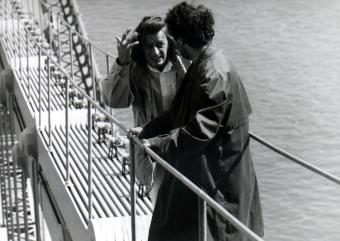 |
NEKEM LAMPAST ADOTT
KEZEMBE AZ UR PESTEN Gottes Laterne in Budapest The Lord's Lantern in Budapest Miklós Jancsó Ungarn 1999 Produktion: Kreativ Média Mühely Weltvertrieb: Magyar Filmunió Városligeti Fasor 38, H-1068 Budapest Tel. (361) 3517760, Fax 3526734 e-mail: filmunio@elender.hu Buch: Miklós Janscó Kamera: Ferenc Grunwalsky Musik: György Ferenczi Ausstattung: Tamás Banovich Ton: Otto Oláh Produzent: József Böyte Darsteller: Zoltán Mucsi, Péter Scherer Sprache: Ungarisch Format: 35mm, 1:1.37, Farbe Länge: 103 Minuten, 25 B/sek. |
Delphi-Filmpalast Mi.17.02.1999 16.30 Arsenal Do.18.02.1999 22.30 Kino 7 im Zoo-Palast Fr.19.02.1999 11.00 Akademie der Künste Fr.19.02.1999 19.30 Babylon Sa.20.02.1999 21.30 |
|
| Kapa und Pepe sind Totengräber in Budapest oder zwei Ganoven oder Banker, Rechtsanwälte, Neureiche oder bankrotte Unternehmer oder vielleicht Boß und Handlanger einer Terrororganisation. Auf alle Fälle sind sie unverwüstlich. Ebenso wie die beiden älteren Herren, der Autor und der Regisseur, die ihre Rolle selber spielen und sich, obwohl ihre Namen auf einer Liste stehen und sie deshalb erschossen werden, davon nicht weiter stören lassen. Leben, Tod, Erfolg und Mißerfolg, Philosophie und vorstädtische Gaunersprache, Humor und Satire werden in den Episoden miteinander vermischt. Der Film besteht nicht aus einer Geschichte, sondern aus einer Reihe merkwürdiger, kleiner Geschichten. Miklós Janscó: „Sagen Sie mal, liebe Zuschauerin, lieber Zuschauer: denken Sie ab und zu darüber nach, wie die Welt beschaffen ist? Ja? Tun Sie das lieber nicht. Leben Sie Ihr Leben. Genießen Sie jeden Tag. Seien Sie froh und glücklich! Sie sind es nicht? Dann geben Sie sich doch Mühe, und kümmern Sie sich um nichts. Schauen Sie, bis auf den Menschen weiß jedes Tier: das Wichtigste im Leben ist, es zu genießen. Nun, unser Film hilft Ihnen ein bißchen dabei. Und, es tut uns leid, aber Sie werden mehr bekommen, als Sie erwarten. Der Film ist abgeklärt. Vorausschauend. Benutzerfreundlich.“ |
Kapa and Pepe are two grave diggers from Budapest or rather two hoodlums or bankers or lawyers, nouveau riche or bankrupt entrepreneurs, but they may even be the boss of some terrorist organisation and his assistant. One thing is certain, they are indestructible. Like the two old gentlemen, the writer and the director who play themselves, and although their names are on some list and they get shot for that, it is obvious that they do not give a damn. Life, death, success and failure, philosophy and fast talk of the slums, humour and satire are mixed in the episodes of the film. It is not one story but a series of strange little stories. The reason why in the end we still feel that there is a connection between them is that they are all set in Central Europe or more exactly in Budapest where anything can happen. Miklós Janscó about his film: “Dear viewer, do you ever reflect upon what the world is like? You do? Oh, please don’t. Live your life. Enjoy every day. Be cheerful and happy. You are not? Pull yourself together and never mind anything. Look, with the exception of man, every animal knows that the most important thing about life is to enjoy it. Well, this film of ours will help you to do so. And, we are very sorry to say, you will get more than you expect. It’s pure. It’s foreseeing. It’s user friendly.” |
| Biofilmographie
/ Biofilmography Miklós Jancsó wurde 1921 in Vác/Ungarn geboren. Er studierte und promovierte an der Kolozsvár-Universityät in Rumänien. Danach besuchte er Vorlesungen über Volkskunde und Kunstgeschichte. 1950 schloß er sein Studium an der Theater- und Filmkunstakademie ab und begann, Wochenschauen zu drehen. Nach vier Jahren wandte er sich dem Dokumentarfilm zu. 1958 entstand sein erster Spielfilm. Seit 1970 arbeitete er außerdem als Inspizient und seit 1983/84 als Chef-Inspizient am Jószef Katona-Theater in Kecskemèt. Miklós Jancsó was born in 1921 in Vác, Hungary. He studied at the Kolozsvár University in Rumania and received a Ph.D. Subsequently, he attended lectures on folklore and art history. In 1950 he graduated from the Academy of Theatre and Film and began to make newsreels. After four years he turned to documentary filmmaking. In 1958 he made his first feature-length film. From 1970 he also worked as a stage-manager and since 1983/84 he has been the main stage-manager at the Jószef Katona Theatre in Kecskemèt. Films (selection) / Filme (Auswahl) 1958: A harangok Rómába mentek (The Bells have Gone to Rome). 1963: Oldás és kütès (Cantata). 1964: Igy jöttem (My Way Home). 1965: Szegènylegènyek (Die Hoffnungslosen/The Round-Up). 1967: Csillagosok, katonák(The Red and the White). 1968: Csend ès kiáltás (Silence and Cry). 1968: Fènyes szelek (Schimmernde Winde, The Confrontation). 1969: Sirokkó (The Winter Wind). 1970: Egi bárány (Agnus Dei); La Pacifista (The Pacifist). 1971: La tecnica e il rito (The Technique and the Rite); Mèg kèr a nèp (Red Psalm). 1973: Roma rivuole Cesare (Rome Wants another Caesar). 1974: Szerelmem, Elektra (Elektreia). 1976: Vizi privati, pubbliche virtů (Vices and Pleasures). 1978: Magyar rapszódia (Hungarian Rhapsody). 1978: Allegro barbaro. 1981: A zsarnok szíve (The Tyrant's Heart). 1985: L'aube (The Dawn). 1986: Szörnyek évadja (Season of Monsters). 1988: Jézus Krisztus horoszkopja (Jesus Christ's Horoscope). 1990: Isten hátrafelé medy (God Walks Backwards). 1991: Kék Duna keringö (The Blue Danube Waltz). 1994: Kövek üzenete (Die Botschaft der Steine / The Message of Stones; Forum 1995). 1996: Szeressük egymást, gyerekek - A nagy agyhalál (Let's Love Each Other - The Great Brain Death). 1998:Nekem lámpást adott kezembe az úr Pesten |
|